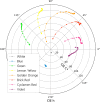The light aging behavior of daylight fluorescent paints: a colorimetric, photographic, Raman spectroscopic and fluorescence spectroscopic study
- PMID: 36320569
- PMCID: PMC9610339
- DOI: 10.1186/s40494-022-00812-4
The light aging behavior of daylight fluorescent paints: a colorimetric, photographic, Raman spectroscopic and fluorescence spectroscopic study
Abstract
Daylight fluorescent pigments with their intense color effects have attracted great interest among artists since their market launch in the mid-twentieth century. Since then they have been widely used in the visual arts. The pigments are mainly compositions of organic fluorescent dyes and optical brighteners diluted in an insoluble resin. Due to the susceptibility of the dyes to visible and UV radiation, their lightfastness is comparatively low. This paper presents a comprehensive study of the color and fluorescence changes of daylight fluorescent paints upon exposure in visible light and ultraviolet radiation conducted on mock-ups of commercial daylight fluorescent pigments. The different aging characteristics of the pigments depend on the color tone. They were recorded by means of photographic and colorimetric documentation. In addition, Raman spectroscopy was used to identify the main dyes of the various pigments, even in the complex system of paints, consisting of primer, binder, resin and dyes, and to determine their degradation during aging. Fluorescence spectroscopy revealed that the change in fluorescent color may not only be due to the decrease in dye concentration, but also to the transformation of the original dyes into other fluorescent compounds during light aging. Finally, this paper provides recommendations for the presentation of artworks containing daylight fluorescent pigments.
Supplementary information: The online version contains supplementary material available at 10.1186/s40494-022-00812-4.
Keywords: Artificial aging; Colorimetry; Contemporary art; DL photography; Daylight fluorescent paints; Dye degradation; Fading; Fluorescence spectroscopy; Raman spectroscopy; UVF photography.
© The Author(s) 2022.
Conflict of interest statement
Competing interestsThe authors declare that they have no competing interests.
Figures















References
-
- Switzer JL, Switzer RC, inventors; Switzer JL, Switzer RC, assignee. Daylight fluorescent pigment compositions. USA patent 2498592. 1950 February 21.
-
- Johnston-Feller R. Color science in the examination of museum objects. Los Angeles: The Getty Conservation Institute; 2001. pp. 205–218.
-
- Deiss A. Das Gegenteil von zurückhaltend: Tagesleuchtfarben in der Kunst. In: Deiss A, Jahn A, Schimpf S, editors. Neon – Vom Leuchten der Kunst. Köln: Wienand Verlag; 2013. pp. 10–25.
-
- Alvarez Martín A, De Winter S, Nuyts G, Hermans J, Janssens K, Van der Snickt G. Multi-modal approach for the characterization of resin carriers in Daylight Fluorescent Pigments. Microchem J. 2020;159:105340. doi: 10.1016/j.microc.2020.105340. - DOI
-
- Christie RM. Fluorescent dyes. Rev Prog Coloration. 1993;23:1–18. doi: 10.1111/j.1478-4408.1993.tb00092.x. - DOI
LinkOut - more resources
Full Text Sources
